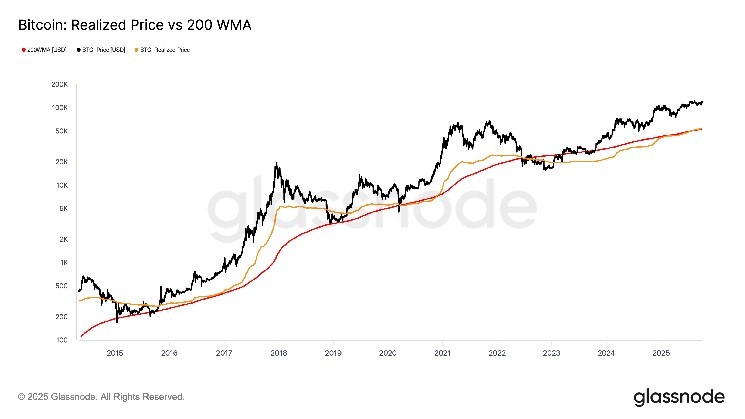Bitcoin Bull Market May Be Just Beginning, Key Metrics Suggest
New Analysis Challenges End-of-Cycle Predictions as Critical Indicators Signal Early Bull Market Phase
In the ever-volatile world of cryptocurrency, timing is everything. While many investors currently view Bitcoin through an end-of-cycle lens—anticipating that Q4 could mark the conclusion of the current market upswing—emerging evidence suggests this bull run may actually be in its nascent stages. Two pivotal metrics have begun to align in a pattern that historically signals the early phase of a prolonged market advance rather than its conclusion.
The Significance of the 200-Week Moving Average Breakthrough
The 200-week moving average (200WMA) represents one of the most respected long-term trend indicators in financial markets, and recent data from blockchain analytics firm Glassnode reveals a crucial development: this indicator has just surpassed the $53,000 threshold for Bitcoin. The significance of this metric cannot be overstated—the 200WMA smooths Bitcoin’s price action over an extended horizon, filtering out short-term noise to reveal the underlying trend. Throughout Bitcoin’s tumultuous history, this indicator has maintained an unwavering upward trajectory, serving as a fundamental benchmark for market participants attempting to distinguish between cyclical movements and secular trends.
“The 200-week moving average has been a reliable indicator of Bitcoin’s macro direction since its inception,” notes cryptocurrency analyst Sarah Bergman. “When we see price action significantly above this level, it has historically indicated sustained bullish momentum rather than an exhausted market cycle.”
Realized Price Crosses Above 200WMA: A Rarely Discussed Bullish Signal
Even more telling than the 200WMA breakthrough alone is its relationship with another sophisticated on-chain metric: the realized price. Currently hovering around $54,000, the realized price—which calculates the average price at which all circulating Bitcoin last moved on the blockchain—has just climbed above the 200WMA. This technical relationship between these two metrics has proven remarkably predictive in previous market cycles and may offer invaluable insight into Bitcoin’s current trajectory.
The realized price provides a unique perspective on market dynamics by effectively measuring the cost basis of the entire market rather than simply the last traded price. It reflects the price at which the average Bitcoin holder acquired their coins, creating a psychological support level that often influences market behavior. When this metric rises above the 200WMA, it frequently signals sustained buying pressure from long-term investors rather than speculative trading—precisely the foundation needed for a durable bull market.
Historical Patterns Reveal Consistent Cyclical Behavior
Examining previous Bitcoin market cycles reveals a remarkably consistent pattern that strengthens the case for an early-stage bull market. During the expansionary phases of 2017 and 2021, the realized price maintained its position above the 200WMA and gradually widened this gap as the bull markets progressed. This divergence typically accelerated during the later stages of bull markets before eventually collapsing, with the realized price falling below the 200WMA—a transition that has reliably signaled the onset of bear markets.
The bear market of 2022 exemplified this pattern perfectly, as the realized price plunged below the 200WMA amid widespread capitulation and market distress. What makes the current market context particularly noteworthy is that the realized price has only recently reclaimed its position above the 200WMA—a development that historically precedes the most substantial phases of price appreciation rather than marking their conclusion.
“What we’re seeing now resembles the market structure of early 2016 and late 2019, both periods that preceded massive bull runs rather than marking their end,” explains Marcus Chen, Head of Research at Blockchain Capital Advisors. “The relationship between these metrics suggests market participants are establishing new cost bases at higher levels, which typically precedes sustained price discovery rather than imminent decline.”
Beyond Technical Indicators: Fundamental Catalysts Supporting Extended Upside
While technical metrics provide compelling evidence for an early-stage bull market, fundamental catalysts further reinforce this possibility. The recent Bitcoin halving event in April 2024 reduced the rate of new Bitcoin issuance, creating supply constraints that typically manifest as price appreciation 12-18 months following the event. Additionally, the approval and launch of spot Bitcoin ETFs have introduced unprecedented institutional capital flows into the cryptocurrency ecosystem, providing a structural demand shift unlike previous cycles.
Regulatory clarity has also improved markedly compared to previous bull markets, with major financial institutions now actively participating in cryptocurrency markets rather than avoiding them. This institutional adoption represents a fundamental change in market composition that could extend the current cycle beyond historical norms. The combination of supply reduction, increased institutional participation, and improving regulatory framework suggests the potential for a more extended and potentially more measured bull market than previous cycles.
Investment Implications and Strategic Considerations
For investors navigating this market environment, the implications are significant. If current metrics indeed indicate an early-stage bull market rather than an exhausted cycle, investment strategies predicated on imminent market tops may prove premature. Rather than preparing for cycle conclusion, market participants might consider positioning for potentially significant further upside, albeit with appropriate risk management given cryptocurrency’s inherent volatility.
“The mistake many investors make is assuming Bitcoin must follow identical cycle lengths to previous markets,” warns veteran cryptocurrency trader Michael Reynolds. “The reality is that as the market matures and institutional participation increases, cycles may extend and exhibit different characteristics than those observed in Bitcoin’s earlier history.”
While no market indicator is infallible, the current alignment of the realized price above the 200-week moving average provides compelling evidence that Bitcoin’s bull market may have considerable room to run. As with all cryptocurrency investments, diversification and risk management remain essential, but dismissing the current market as late-cycle may prove to be a costly miscalculation based on the historical reliability of these particular metrics.
As Bitcoin continues its volatile journey, investors would be wise to consider both technical indicators and fundamental catalysts rather than relying solely on calendar-based cycle predictions. The evidence suggests that rather than witnessing the final act of this bull market, we may instead be watching just the opening scenes of a much longer performance.














